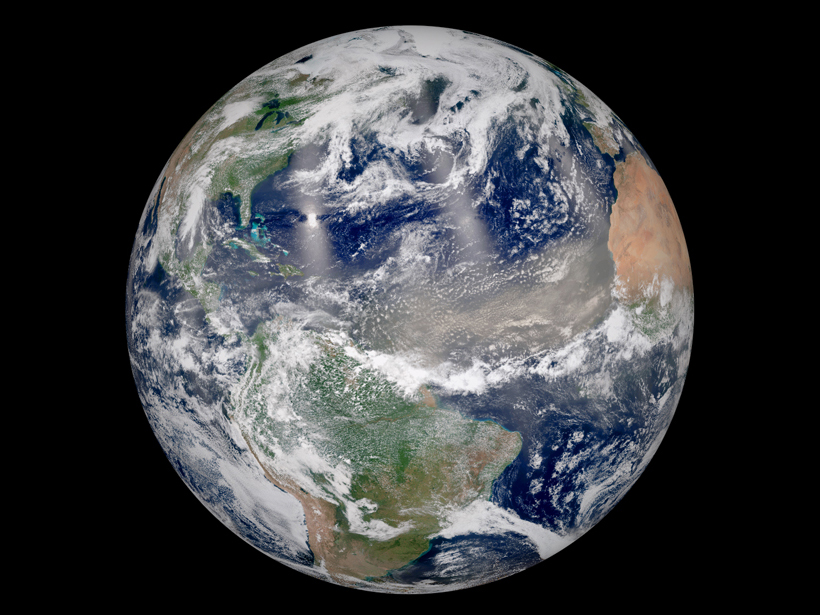Large quantities of African dust are carried to the Caribbean Basin every year, causing concerns about the impact on human health. Because of dust, the concentration of airborne particulate matter in the region frequently exceeds the World Health Organization guideline for particles measuring less than 10 micrometers in diameter. Further, the shifting global climate could exacerbate the problem.
To address these concerns, 48 scientists engaged in Caribbean studies met for a symposium last May at the University of Miami in Miami, Fla. Participants included researchers, atmospheric modelers, climatologists, and representatives from the public health community.
Although African dust is widely believed to be linked to the high incidence of asthma in the Caribbean, there have been few regional studies of asthma or other aerosol-related health issues. Epidemiological studies were presented at the meeting, but the results were inconclusive or contradictory. Participants agreed that there is a need for better data on cardiovascular and other respiratory illnesses, in addition to asthma.
There is a also a need for more widespread air quality measurements, which are currently made only in Barbados, Puerto Rico, Guadeloupe, Martinique, and Cayenne. Participants agreed to implement an ad hoc federated network to enable accurate tracking and quantifying of African dust outbreaks and the transport of this dust across the Caribbean to the coastline of the southern United States. NASA solar tracking photometers and micropulse lidars are located at a number of sites, and participants discussed increasing the number of sites. As an outcome of the meeting, a website (currently in beta testing) will integrate these observations in real time with Moderate Resolution Imaging Spectroradiometer (MODIS) satellite products and aerosol model forecasts.
Plans were also made to develop a dust warning capability linked to public health services in the region so that alerts could be issued to susceptible populations. The Caribbean effort will be coordinated with the World Meteorological Organization Sand and Dust Storm Warning Advisory and Assessment System, which currently focuses on African dust and its impact on Europe and the Middle East.
There is widespread concern about the effects of climate change on dust transport and health in the region. The 50-year Barbados dust record shows significant changes linked to climate, most notably the intense droughts in the 1970s and 1980s. Discussions focused on the considerable research that has gone into dust-climate linkages on scales ranging from regional (e.g., changes in rainfall, vegetation, land use, wind conditions in Africa) to planetary teleconnections (e.g., El Niño, the Atlantic Multidecadal Oscillation). Although this work has yielded promising results, large uncertainties still exist, exemplified in the Intergovernmental Panel on Climate Change projections for Africa, which are indefinite for the two most critical dust-related parameters, soil moisture and wind fields.
A coordinated study of air quality and the health impacts across the Caribbean Basin could serve as a test bed for evaluating dust-climate models and the consequent dust-health effects.
Symposium participants concluded that a coordinated study of air quality and the health impacts across the Caribbean Basin could serve as a test bed for evaluating dust-climate models and the consequent dust-health effects. Because the Caribbean is relatively unaffected by major aerosol sources other than dust, health impacts could be more directly linked to dust. The information gained from these studies could provide insights on possible health impacts in other dusty regions of the world where 2.1 billion people live and where there is little research on aerosol-health issues.
The symposium was supported by the National Integrated Drought Information System of the National Oceanic and Atmospheric Administration.
—Joseph M. Prospero, Department of Atmospheric Sciences, Rosenstiel School of Marine and Atmospheric Science, University of Miami, Miami, Fla.; email: [email protected]; and Henry F. Diaz, Earth Systems Research Laboratory, National Oceanic and Atmospheric Administration, Boulder, Colo., and Cooperative Institute for Research in Environmental Sciences, Boulder, Colo.
Citation: Prospero, J. M., and H. F. Diaz (2016), The impact of African dust on air quality in the Caribbean Basin, Eos, 97, doi:10.1029/2016EO043831. Published on 21 January 2016.
Text © 2016. The authors. CC BY-NC 3.0
Except where otherwise noted, images are subject to copyright. Any reuse without express permission from the copyright owner is prohibited.

